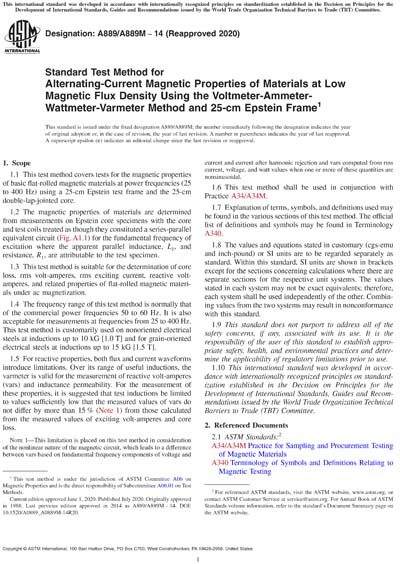Most recent
ASTM A889/A889M-14(2020)
Standard Test Method for Alternating-Current Magnetic Properties of Materials at Low Magnetic Flux Density Using the Voltmeter-Ammeter-Wattmeter-Varmeter Method and 25-cm Epstein Frame
1.1 This test method covers tests for the magnetic properties of basic flat-rolled magnetic materials at power frequencies (25 to 400 Hz) using a 25-cm Epstein test frame and the 25-cm double-lap-jointed core.
1.2 The magnetic properties of materials are determined from measurements on Epstein core specimens with the core and test coils treated as though they constituted a series-parallel equivalent circuit (Fig. A1.1) for the fundamental frequency of excitation where the apparent parallel inductance, L1, and resistance, R1, are attributable to the test specimen.
1.3 This test method is suitable for the determination of core loss, rms volt-amperes, rms exciting current, reactive volt-amperes, and related properties of flat-rolled magnetic materials under ac magnetization.
1.4 The frequency range of this test method is normally that of the commercial power frequencies 50 to 60 Hz. It is also acceptable for measurements at frequencies from 25 to 400 Hz. This test method is customarily used on nonoriented electrical steels at inductions up to 10 kG [1.0 T] and for grain-oriented electrical steels at inductions up to 15 kG [1.5 T].
1.5 For reactive properties, both flux and current waveforms introduce limitations. Over its range of useful inductions, the varmeter is valid for the measurement of reactive volt-amperes (vars) and inductance permeability. For the measurement of these properties, it is suggested that test inductions be limited to values sufficiently low that the measured values of vars do not differ by more than 15 % (Note 1) from those calculated from the measured values of exciting volt-amperes and core loss.
Note 1: This limitation is placed on this test method in consideration of the nonlinear nature of the magnetic circuit, which leads to a difference between vars based on fundamental frequency components of voltage and current and current after harmonic rejection and vars computed from rms current, voltage, and watt values when one or more of these quantities are nonsinusoidal.
1.6 This test method shall be used in conjunction with Practice A34/A34M.
1.7 Explanation of terms, symbols, and definitions used may be found in the various sections of this test method. The official list of definitions and symbols may be found in Terminology A340.
1.8 The values and equations stated in customary (cgs-emu and inch-pound) or SI units are to be regarded separately as standard. Within this standard, SI units are shown in brackets except for the sections concerning calculations where there are separate sections for the respective unit systems. The values stated in each system may not be exact equivalents; therefore, each system shall be used independently of the other. Combining values from the two systems may result in nonconformance with this standard.
1.9 This standard does not purport to address all of the safety concerns, if any, associated with its use. It is the responsibility of the user of this standard to establish appropriate safety, health, and environmental practices and determine the applicability of regulatory limitations prior to use.
1.10 This international standard was developed in accordance with internationally recognized principles on standardization established in the Decision on Principles for the Development of International Standards, Guides and Recommendations issued by the World Trade Organization Technical Barriers to Trade (TBT) Committee.
Content Provider
ASTM International [astm]






